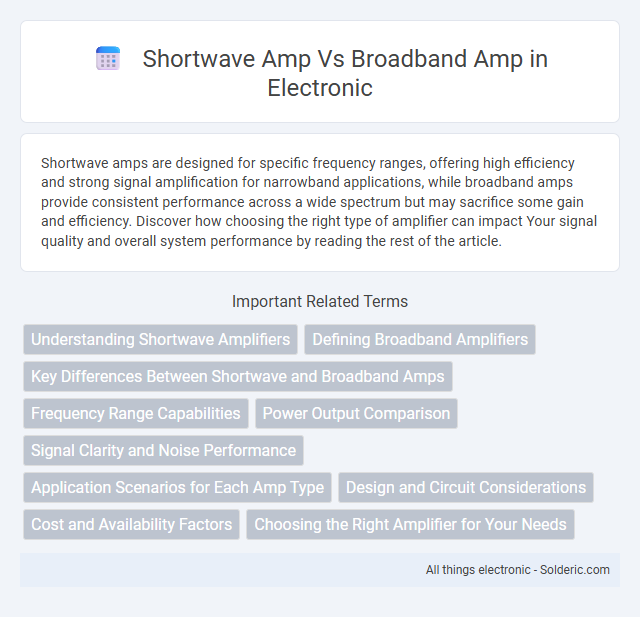Shortwave amps are designed for specific frequency ranges, offering high efficiency and strong signal amplification for narrowband applications, while broadband amps provide consistent performance across a wide spectrum but may sacrifice some gain and efficiency. Discover how choosing the right type of amplifier can impact Your signal quality and overall system performance by reading the rest of the article.
Comparison Table
| Feature | Shortwave Amplifier | Broadband Amplifier |
|---|---|---|
| Frequency Range | 3 MHz to 30 MHz (Shortwave bands) | Wide range, typically 1 MHz to several GHz |
| Application | Shortwave radio communication, amateur radio | Multiple frequency bands, cable TV, wireless comms |
| Gain Uniformity | Optimized for specific shortwave bands | Consistent gain across wide frequency range |
| Power Output | Low to medium power, suits narrowband signals | Varies; designed for broad, diverse signals |
| Noise Figure | Low noise suitable for weak shortwave signals | Moderate noise optimized for broadband input |
| Design Complexity | Frequency-specific tuning, simpler circuitry | Advanced design to maintain performance over broad bands |
| Usage Scenario | HF radio, maritime and aviation shortwave comms | TV broadcasting, wireless networks, signal distribution |
Understanding Shortwave Amplifiers
Shortwave amplifiers are designed to boost signals specifically within the shortwave radio frequencies, typically ranging from 1.6 to 30 MHz, ensuring clearer reception and transmission across long distances. These amplifiers optimize performance by matching impedance and minimizing noise in the shortwave spectrum, unlike broadband amplifiers that cover a wider frequency range but with less specialization. Understanding the technical specifications such as gain, power output, and linearity is crucial when selecting a shortwave amplifier for efficient signal amplification and enhanced communication quality.
Defining Broadband Amplifiers
Broadband amplifiers are designed to operate efficiently over a wide range of frequencies, making them ideal for applications requiring consistent gain across multiple bands. Unlike shortwave amplifiers, which target specific frequency ranges such as the 3 to 30 MHz spectrum, broadband amplifiers support frequencies spanning from kilohertz to several gigahertz. Your choice depends on whether you need specialized shortwave performance or versatile amplification for diverse frequency requirements.
Key Differences Between Shortwave and Broadband Amps
Shortwave amplifiers are designed specifically for narrow frequency ranges, optimizing performance for amateur radio bands and long-distance communication. Broadband amplifiers operate over a wide frequency range, making them versatile for various applications like RF testing and broadcasting. Key differences include frequency coverage, gain stability, and application focus, with shortwave amps offering higher gain efficiency in limited bands and broadband amps providing consistent amplification across diverse frequencies.
Frequency Range Capabilities
Shortwave amplifiers typically operate within the 3 to 30 MHz frequency range, providing high power output optimized for long-distance communication on shortwave bands. Broadband amplifiers cover a wider frequency spectrum, often from HF through VHF and sometimes UHF, enabling versatile use across various communication protocols and applications. The frequency range capabilities directly influence amplifier selection based on the specific needs of radio operators seeking targeted shortwave performance or broad-spectrum flexibility.
Power Output Comparison
Shortwave amps typically offer high power output optimized for narrow frequency bands, ensuring efficient amplification in specific shortwave ranges. Broadband amps provide moderate power output across a wide frequency spectrum, prioritizing versatility over peak power in any single band. Your choice depends on whether you need focused high power for specific frequencies or general coverage with consistent performance across multiple bands.
Signal Clarity and Noise Performance
Shortwave amplifiers typically offer superior signal clarity by enhancing narrow frequency bands, reducing adjacent channel interference and improving overall noise performance in long-distance communications. Broadband amplifiers cover a wide frequency range but often introduce higher noise levels and reduced signal-to-noise ratio due to less selective filtering. Optimizing amplifier choice depends on balancing the need for targeted frequency amplification and minimizing noise for clearer reception.
Application Scenarios for Each Amp Type
Shortwave amps are optimized for high-frequency communication applications such as amateur radio, maritime, and aviation where narrowband signals require precise amplification. Broadband amps excel in scenarios demanding wide frequency coverage, including spectrum monitoring, electronic warfare, and multi-band signal processing. Selecting the appropriate amplifier depends on frequency range requirements, signal bandwidth, and specific use cases like long-distance communication or real-time signal analysis.
Design and Circuit Considerations
Shortwave amplifiers are specifically designed with narrowband circuits optimized for frequencies typically between 1.8 MHz and 30 MHz, using tuned LC circuits and high-Q components to achieve maximum gain and efficiency. Broadband amplifiers employ wideband design techniques such as wideband transformers and distributed element networks to provide consistent performance over a much broader frequency range, often from HF to VHF bands. Circuit considerations for shortwave amps emphasize selective amplification and harmonic suppression, while broadband amps prioritize flat frequency response and stable operation across an extended spectrum.
Cost and Availability Factors
Shortwave amplifiers often come at a higher cost due to specialized components designed for narrow frequency ranges, impacting their availability primarily through niche manufacturers. Broadband amplifiers provide a more cost-effective solution with widespread availability, leveraging mass-produced components suitable for multiple frequency bands. Your choice depends on budget constraints and whether you need a specialized or versatile amplification solution.
Choosing the Right Amplifier for Your Needs
Selecting the right amplifier depends on your specific application and frequency range requirements. Shortwave amplifiers are optimized for high-frequency bands, offering precise signal boosting ideal for amateur radio and international broadcasts. Broadband amplifiers provide wide frequency coverage and versatility, making them suitable for general-purpose use and multi-band communications where flexibility is key.
Shortwave amp vs Broadband amp Infographic

 solderic.com
solderic.com